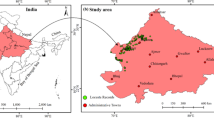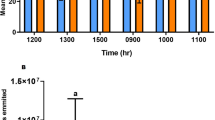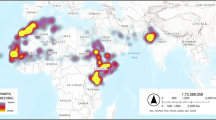Abstract
NATURAL populations of locusts are characterized by large fluctuations in numbers, accompanied by changes in morphology, colour and behaviour in both the nymphs (hoppers) and the adults. When numbers are high, the hoppers aggregate into bands containing from a few hundred to several thousand individuals. Similar gregarious hoppers can be produced in the laboratory by rearing several together in one cage1. There is much circumstantial evidence to suggest that, provided the total numbers are sufficient, the formation of hopper bands depends partly on a patchy physical environment, especially a vegetation mosaic, and partly on strong attractions between hoppers2,3.
This is a preview of subscription content, access via your institution
Access options
Subscribe to this journal
Receive 51 print issues and online access
$199.00 per year
only $3.90 per issue
Buy this article
- Purchase on SpringerLink
- Instant access to full article PDF
Prices may be subject to local taxes which are calculated during checkout
Similar content being viewed by others
References
Faure, J. C., Bull. Ent. Res., 23, 293 (1932).
Ellis, P. E., and Ashall, C., Anti-Locust Bull. No. 25 (in the press).
Davey, J. T., and Johnston, H. B., Anti-Locust Bull. No. 22 (1956).
Ellis, P. E., Behaviour, 5, 225 (1953).
Ellis, P. E. (unpublished laboratory data).
Author information
Authors and Affiliations
Rights and permissions
About this article
Cite this article
ELLIS, P. Differences in Social Aggregation in Two Species of Locust. Nature 178, 1007 (1956). https://doi.org/10.1038/1781007a0
Issue date:
DOI: https://doi.org/10.1038/1781007a0
This article is cited by
-
Plant Size-dependent Escaping Behavior of Gregarious Nymphs of the Desert Locust, Schistocerca gregaria
Journal of Insect Behavior (2013)
-
Aggregation in the lime aphid (Eucallipterus tiliae L.)
Oecologia (1976)
-
Environmental and Behavioural Processes in a Desert Locust Outbreak
Nature (1968)
-
The Prothoracic Gland and Colour Change in Locusts
Nature (1961)



